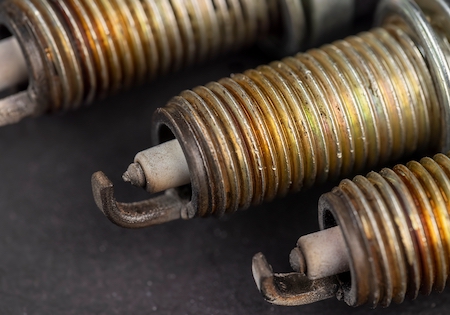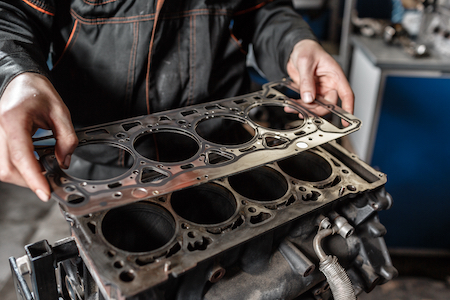Imagine driving on your usual route when suddenly, you hear an unusual noise: a rhythmic tapping or pinging sound coming from your engine. Your heart sinks, and questions start racing through your mind.
What is that noise? Is it serious? How much will this cost to fix?
This unsettling sound is often referred to as engine knocking, and while it can be alarming, it’s also your car’s way of telling you something needs attention. Ignoring it could lead to costly repairs or even severe engine damage.
So, what exactly is engine knocking, what causes it, and how can you fix it? Let’s break it down.
What Is Engine Knocking?
Engine knocking, also known as “pinging,” is a repetitive tapping or knocking noise that occurs when something disrupts the normal combustion process in your engine. Normally, your engine’s air-fuel mixture burns smoothly in controlled explosions, driving the pistons and powering the car.
When knocking occurs, pockets of air and fuel combust prematurely or unevenly, creating shock waves that result in a distinct knocking sound.
Why Engine Knocking Is a Concern
Engine knocking isn’t just an annoyance—it’s a sign of potential trouble. Left unchecked, it can:
- Damage Internal Components: Repeated knocking can cause stress on your pistons, cylinders, and connecting rods, leading to wear and even catastrophic failure.
- Reduce Performance: Knocking can affect the timing and efficiency of combustion, leading to reduced power and acceleration.
- Lower Fuel Efficiency: Irregular combustion means your engine isn’t operating as efficiently as it should, leading to higher fuel consumption.
- Increase Emissions: Improper combustion releases more pollutants, negatively impacting the environment and potentially causing your car to fail emissions tests.
You love your car. You hope it’ll last for years. If you can avoid any of these, it’s worth it, right?
Let’s keep learning.
Common Causes of Engine Knocking
The good news is there are common causes of engine knocking. When you pinpoint these issues, you know immediately you have a problem, and can address it quickly. Here are the most common culprits:
Low-Quality Fuel
Low-octane or contaminated fuel can lead to knocking by allowing uncontrolled combustion. High-performance engines, in particular, require premium fuel to prevent this.
Carbon Buildup
Over time, carbon deposits can accumulate on your engine’s valves and combustion chambers, disrupting the normal air-fuel mixture and causing pre-ignition.
Incorrect Air-Fuel Mixture
If the air-fuel mixture is too lean (not enough fuel), it can lead to higher temperatures in the combustion chamber, increasing the risk of knocking.
Faulty Spark Plugs
Worn or incorrect spark plugs can misfire, disrupting the timing of combustion and leading to knocking sounds.
Engine Timing Issues
If your engine’s timing is off—due to a worn timing belt or improper adjustment—it can lead to knocking by causing premature ignition of the air-fuel mixture.
Low Oil Levels
Oil lubricates and cools engine components. Low oil levels can increase friction, overheating, and knocking sounds.
Worn Rod Bearings
The connecting rods inside your engine rely on bearings to function smoothly. When these bearings wear out, they can cause a knocking or rattling sound.
How to Diagnose Engine Knocking
Think your car might be experiencing engine knocking? Here’s how to confirm and pinpoint the issue:
Listen to the Sound
- Is it a sharp, metallic knock or a softer tapping noise?
- Does it increase with engine speed?
Check the Dashboard
- Look for warning lights like the check engine light or oil pressure light.
Inspect Oil Levels
- Use the dipstick to ensure your oil level is adequate. Low oil levels can contribute to knocking.
Examine Fuel and Timing
- If you recently refueled, did you use the correct octane level?
- Have your engine’s timing checked by a mechanic if you suspect timing issues.
Consult a Mechanic
- A professional mechanic can use diagnostic tools to scan for error codes and inspect internal engine components for damage.
How to Fix Engine Knocking
Okay, so you’re pretty sure your car is experiencing engine knocking. The noises are frightful, and you’ve said “yes” to a lot of the things in this article. The right fix depends on the cause of the knocking. Here’s a breakdown of common solutions:
Switch to Higher-Quality Fuel
- If low-octane fuel is the culprit, switch to a higher-octane option recommended by your car’s manufacturer. This can help prevent further knocking.
Replace Spark Plugs
- If your spark plugs are worn or incorrect for your engine, replacing them can resolve misfires and improve combustion timing.
Adjust Engine Timing
- Timing adjustments can be made by a mechanic to ensure proper synchronization of the air-fuel mixture and ignition.
Check for Carbon Buildup
- A professional cleaning of your engine’s combustion chambers can remove carbon deposits and improve performance.
Change the Oil
- Regular oil changes with the correct grade of oil can prevent overheating and reduce wear on engine components.
Replace Worn Bearings
- If knocking is caused by worn rod bearings, this is a more complex repair that typically requires a mechanic to replace the bearings or other internal components.
Preventing Engine Knocking
Reading through this list probably gives you a pretty good idea of what you can do to prevent engine knocking, but let’s walk through some of our top tips. Prevention is always better than repair. Here’s how to keep your engine running smoothly:
Use the Right Fuel
Always use the octane rating recommended by your car’s manufacturer.
Stick to Regular Maintenance
Schedule regular oil changes and tune-ups to keep your engine in top condition.
Avoid Aggressive Driving
Hard acceleration and high RPMs can increase wear and the likelihood of knocking.
Address Warning Signs Early
Don’t ignore unusual sounds, warning lights, or performance issues. Early intervention can save you from expensive repairs.
Clean the Engine Periodically
Use fuel additives occasionally to reduce carbon buildup and keep your fuel system clean.
When to Seek Professional Help
If engine knocking persists despite trying basic fixes, it’s time to visit a mechanic. Persistent knocking could indicate:
Keep Your Engine Knock-Free
Engine knocking can be an unsettling issue, but with timely attention and proper care, you can address the problem and prevent it from happening in the future.
If your car is experiencing knocking sounds or showing other signs of trouble, don’t wait—schedule an appointment with us today. Our team of expert mechanics can diagnose and fix the issue, ensuring your car runs smoothly and safely for miles to come.










